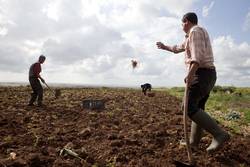Background

- Farmers clearing a field after harvesting broccoli, Ghor El Melh -Tunisia
Land degradation and desertification are serious environmental and socio-economic problems that affect over 250 million people globally. In addition, some one billion people in over one hundred countries especially in Sub-Saharan Africa (SSA) are at risk (UNCCD).
In Kenya, over 80 percent of the land area is classified as Arid and Semi-Arid Land (ASAL) and a majority of this area is affected by moderate to severe land degradation and desertification. About 10 million people (30 percent of Kenya’s population) live in the ASALs and over half of these live below the poverty line (subsisting on <us$1> </us$1>
The majority of the population in Kenya’s ASALs are pastoralists and agro-pastoralists but increasingly, farmers from the overcrowded higher potential areas have migrated into the drylands causing changes in land use, privatization of communal land and increasing pressure on land resources. ASALs and their inhabitants have long been marginalized politically, socially and economically. Past development initiatives in ASALs both in Kenya and elsewhere have been characterized by:
- changes in the traditional way of life,
- unsustainable resource use owing to increasing human and livestock populations,
- inappropriate Government policies,
- security and conflict problems,
- poor provision of services and
- remoteness and poor road network.
As a result, the successes of ASAL development projects in past decades have been few. A common problem for many of these previous programmes and policies has been the lack of commitment and coordination between sector ministries.
The challenge in the ASALs in Kenya and the rest of SSA is to develop an innovative approach to sustainable land management (SLM) where resource conservation and land rehabilitation can be combined with improved livelihoods and income generation for local communities and farmers/herders. The Government of Kenya (GoK) is seeking GEF assistance to face these interlinked local to global challenges through this project, in accordance with the TerrAfrica SLM strategic framework and process. In this regard, intervention will be at two levels:
- Firstly, participatory farmer field school (FFS) interventions to promote SLM learning-by-doing and adaptation with selected agro-pastoral communities in four ASAL districts: Narok, Mbeere, Kyuso and Garissa – this will build on local agropastoral knowledge systems and innovations as well as modern science and technology.
- Secondly, policy development to ensure due consideration to SLM at both central and local levels through: i) district experiences that will feed into the Kenya Strategic Investment Framework and, in turn, provide feedback and support for enhanced local implementation; and ii) links with research to monitor and assess progress in addressing land degradation, poverty and food security dimensions.
